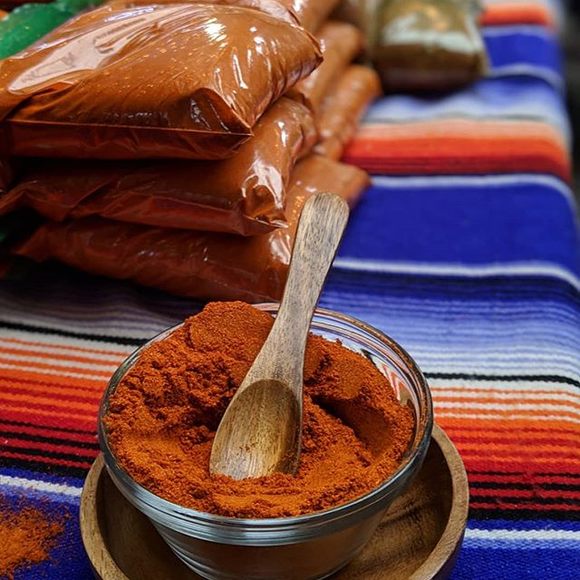Ingredients & Condiments
Chimayó Chile Pepper
This pepper's sweet taste and long, slow burn is found in a single town.
Like their mother’s cooking or a favorite childhood treat, people have strong feelings about the flavor of chimayó chiles and chile powder.
It has to much to do with chimayó’s sweetness, which is rare in a hot chile pepper and followed by a long, slow burn that lingers like an interesting house guest, as opposed to the abrupt interruption of a door-to-door salesman. They’re smoky too, and their spice is rated just above that of your average jalapeno.
Chimayó’s are grown mostly in family gardens and small farms, often from seeds handed down from one generation to the next, in and around the town of Chimayó, New Mexico, 26 miles north of Santa Fe. The town takes its name from the Tewa Indian word for the surrounding rocky, red landscape, and the chile’s unique flavor has much, if not everything, to do with the soil and climate in which it is cultivated. Hot days, chilly nights, and short growing seasons mean unpredictable harvests of the crooked little chile, which is time consuming to roast and peel because of its thin skin and irregular size, compared to larger, standard, commercially grown New Mexican chiles, a staple crop in the southern half of the state. Those left to ripen and redden on the vine are then sun-dried in long hanging chains called ristras. Traditionally, the length of the ristra matched the height of the person stringing it and was said to supply that individual with enough chimayó chiles to grind into powder (known as molido) to last a year.
The chimayó is what is known as a native or landrace chile, one of several local descendants of the first chiles believed to have been brought to the region by Spanish conquistadors in the 16th century. Isolated agriculturally in rural pockets, these chiles took on the names—Santa Domingo, Nambe, Cañoncito—of the remote pueblos where they were traditionally grown, and they have long been important parts of the diet and cuisines of local hispanic and Native American families. Their isolation, say agriculturalists, contributes to their varying and unique flavor profiles. Of the pack, the chimayó is considered by many to be the crown jewel.
Whether eaten fresh, roasted, dried and flaked (called caribe), or ground into molido, chimayós add their distinctive flavor to many of New Mexico’s signature dishes, where chiles in general take center-stage: in posole (hominy stew), simmering pots of beans, or carne adovada, pork shoulder marinated overnight and then slow-baked for hours in a slurry made with roasted chunks of chimayó chile pepper. The humblest, though most common use of chiles is in the roux-based red chile sauce, chile colorado, which is a staple on New Mexicans’ tables. Sauces made with chimayós have that distinctive perfume-y sweetness up front, followed by the burn devotees seek out. Some temper that flavor with a bit of vinegar, or oregano. Others let the purity of the chimayó’s unique taste stand on its own.
Where to Try It
-
El Potrero Trading Post Website
17 Santuario Dr # A, Chimayo, New Mexico, 87522, United StatesThis small store, which is a very short walk from the Santuario de Chimayó, sells chimayó chile powder year round along with art, religious goods, and other culinary ingredients. Call to ask about ordering the powder.
-
Rancho de Chimayo Website
300 Juan Medina Rd, Chimayo, New Mexico, 87522, United StatesRistras hang from the roof at this widely acclaimed restaurant located in a 19th-century hacienda. Order the carne adovada, which is made with the chile when it is in season.
Written By
T Tom VerdeSources
- www.atlasobscura.com/articles/new-mexico-chile-peppers
- www.atlasobscura.com/articles/tree-shrew-hot-pepper
- www.pepperscale.com/chimayo-pepper/
- www.saveur.com/article/Kitchen/Chimayos-Chile-Culture
- www.foodandwine.com/travel/sante-fe-chimayo-chile-counterfeit
- www.yesmagazine.org/issues/education-uprising/a-passion-for-peppers-the-movement-to-save-new-mexico-s-treasured-chiles
The Atlas Obscura Podcast is Back!

















